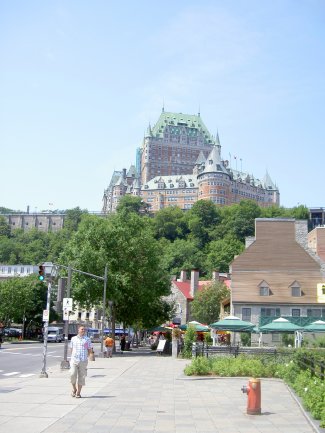
Quebec City, deriving its name from the Indian word, Kebec (meaning where the river narrows), was built atop a cliff, overlooking the St. Lawrence. A natural fortress, it became the capital of New France and fended off numerous attacks until occupied by the British in 1759. After the battle on the Plains of Abraham, New France became a British colony until confederation in 1867 when it became a part of Canada.
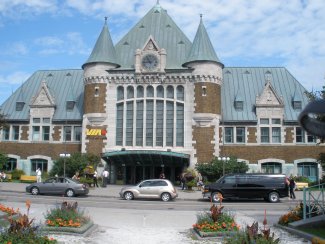
A historic treasure, Quebec City, in 2008 celebrated its 400th anniversary. An enchanting French monument planted in North America, the city is the capital of the province of Quebec and home of the National assembly, a busy port, and one of Canada’s most well-known tourist destinations.
Quebec City’s charm comes from a combination of its architectural, cultural and historical elements. The mixture of French, English and modern styles of buildings gives the city a very catchy appeal. This along with its setting make it one of the most picturesque towns in Canada. At the heart of Quebec City’s charisma is the old walled town the only walled city in North America, drawing the majority of visitors.
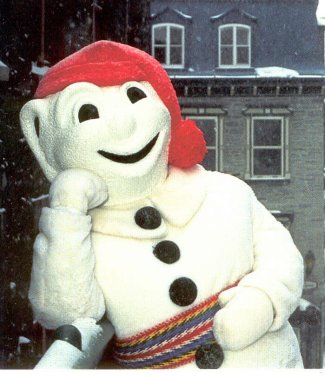
In this walled compact area, a living history book of the town, are the most interesting sights in the city. The narrow cobblestone streets and quaint town squares – relics from the past, the venerable churches, including the first stone church built in North America in 1632, and turreted buildings give the area a distinct medieval European look.
There is plenty to see and do along these worn streets such as historic churches, hotels, forts and museums and, in between, boutiques, shops, galleries and cafes or bistros. The concentration of historic buildings in old Quebec, some dating to the 1600s, is the reason that Old Quebec was designated by UNESCO in 1985 as a World Heritage Site.
 A small part of the old city known as Basse-Ville or Lower Town, next to the river, is the oldest quarter in the city, filled with impressive renovated old structures from the 1600s and 1700s. It was here where Samuel de Champlain founded New France in 1608. Basse-Ville lies outside the walls, between the base of the cliff and the river, and has a good number fine shops and restaurants. Stairways lead down to Basse-Ville from the bluff, but an easier way to go is the renovated funicular – a glass elevator sliding up and down a ramp that has been in use since 1879.
A small part of the old city known as Basse-Ville or Lower Town, next to the river, is the oldest quarter in the city, filled with impressive renovated old structures from the 1600s and 1700s. It was here where Samuel de Champlain founded New France in 1608. Basse-Ville lies outside the walls, between the base of the cliff and the river, and has a good number fine shops and restaurants. Stairways lead down to Basse-Ville from the bluff, but an easier way to go is the renovated funicular – a glass elevator sliding up and down a ramp that has been in use since 1879.
These two old areas contain the majority of the city’s interesting sights, but, beyond the walls of Vieux Quebec, the modern sections that encompass parks, office buildings, shopping malls and modern homes also have their appeal. In these newer areas and in the old city are found 27 museums. The most important of these being the: Museum of Civilization in Basse-Ville which focuses on Quebec’s provincial history, but has exhibits relating to other cultures from around the world; Museum of French America, noted for its stunning chapel; and Museum of Quebec; an architectural master piece, it is one of Quebec’s most important museums, containing an extensive collection of Quebecois art and historical documents.
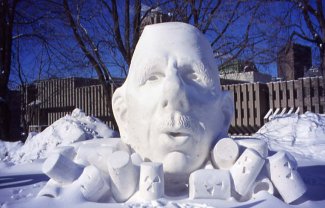 After visitors have explored Vieux Quebec, they should venture out to explore the remainder of the city. Immediately, beyond the walls of the old city is the Grande Allee, dominated by Victorian mansions of the late 1800s, and considered by locals to be a smaller version of Paris’s Champs Elysees. Here, where the beautiful people nightly congregate, there is a large concentration of cafes, bistros, restaurants and some of Quebec City’s best pubs and nightspots. The most important public building along the Grande Allee is the impressive National Assembly, more than a hundred years old.
After visitors have explored Vieux Quebec, they should venture out to explore the remainder of the city. Immediately, beyond the walls of the old city is the Grande Allee, dominated by Victorian mansions of the late 1800s, and considered by locals to be a smaller version of Paris’s Champs Elysees. Here, where the beautiful people nightly congregate, there is a large concentration of cafes, bistros, restaurants and some of Quebec City’s best pubs and nightspots. The most important public building along the Grande Allee is the impressive National Assembly, more than a hundred years old.
The best time to travel to Quebec City is during the famous January-February Quebec Winter Carnival – a massive 17-day blowout, known as ‘Mardi Gras in the snow; or during the July Quebec International Summer Festival – the largest French-speaking cultural celebration on the continent; or during the SAQ New France Festival, celebrating the arrival of the first European settlers in North America
These three festivals are at the top of the list of some 29 annual events in the city. In the words of one of our guides, “Any time you come, there will be one or two festivals in town. We like to have fun and, of course, like any visitor, you can join in.”
IF YOU GO
Facts About Quebec City:
1) When in Quebec City, take a cruise on the Louis Jolliet cruise ship operated by ‘AML Cruises’ moored alongside the docks under the Chateau Frontenac on the edge of the Old Quebec – contact by toll free number 1-866-856-6668 for this and other cruises by the same company.
2) Two fulfilling tours to take are offered by Viator Tours from Quebec City for; Montmorency Falls and the shrine of Ste-Anne-de-Beaupre – Cost $45.56; City Sightseeing Tour – Cost $32.40. (Prices quoted in CDN dollars.)
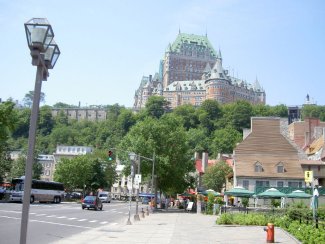
4) Where to Stay: Hotels offer some 12,000 rooms in and around the old city – 2000 of these, international class. Two top hotels are the Hilton Quebec and the Fairmont Le Chateau Frontenac – the towering symbol of Quebec City.
5) The best place to buy souvenirs in Quebec City is rue Petit Champlain in Basse-Ville, and the trendiest part is the area around the railway station.
6) 4 ski centres with 120 slopes and 30 golf courses are all within a 40-minute drive from Quebec City.
Some Additional Important Sites in Quebec City Not to Miss:
Basilique Notre Dame de Quebec – a 350 year-old cathedral, which serves as a burial spot for most of Quebec’s bishops.
National Battlefields Park, includes the famous “Plains of Abraham’, where the British defeated the French in 1759 and ended French rule in Canada. Today, Battlefields Park is the city’s premier green space.
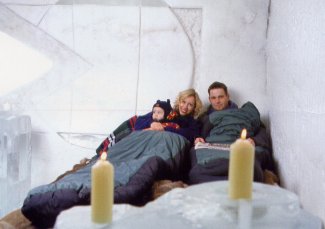 Citadelle – a star-shaped fortress, flanking the city’s fortifications. In summer, an impressive changing of the guard ceremony takes place daily.
Citadelle – a star-shaped fortress, flanking the city’s fortifications. In summer, an impressive changing of the guard ceremony takes place daily.
Museum of Ursulines – a quaint little museum, which houses the oldest still functioning girls’ school in North America.
Museum of Inuit Art – first museum south of the Arctic exclusively dedicated to Inuit art and culture.
Parc Aquarium de Quebec – a fine wonderland of animals.
Wendake, an Indian reserve in the middle of suburbia where one can visit the Huron-Wendat Traditional Village, a re-created Huron village that is surrounded by a wood palisade. The Hotel-Musee Premires Nations, on the edge of the village, is a striking structure that connects a modern hotel and restaurant with a jewel of a museum.
Cartier-Brebeuf National Historic Park, commemorates the spot where Jacques Cartier once wintered. Here also, a replica of his ship is on display.
For Further Information About Quebec City, Contact:
Tourisme Quebec: for complete tourist information Quebec, call: (514) 873-2015 or toll free: 1-877-363-7777, or visit web the site: www.bonjourquebec.com





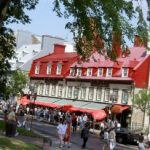

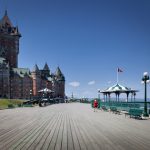

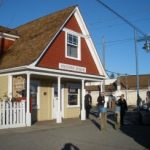

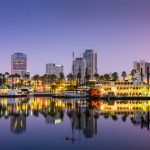
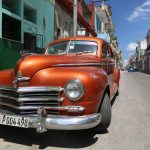

Leave a Reply